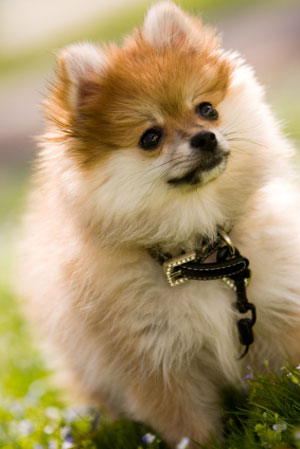
Care and exercise
Exercise for the average Pom is well taken care of by its own rushing around the house, but it will appreciate the occasional walk or romp in the garden. The coat is high-maintenance it requires brushing daily to keep it clean and free of mats and tangles and thorough combing and brushing during the twice-annual shedding of undercoat. Eyes need daily attention and as Pomeranians are susceptible to early tooth loss dental care is important.
Suitability
The Pomeranian is an attractive, likeable little dog who will make a most rewarding pet in almost any circumstance, as long as its owner is ready and willing to spend half an hour or so per day on grooming. Its diminutive size and very fine bones suggest that small children or rough play are best avoided.
This very affectionate breed is sure to win your heart.
Not only are they great little dogs, they are also very loyal and loving to their owners and friends.
Looking like a ball of fluff on legs, this delightful little two kilogram dog was, about 120 years ago, once seven times larger, averaging some 14kg. Descended from such breeds as the Samoyed, Elkhound, Finnish Spitz and possibly the Chow Chow, the passion of the Victorian era of miniaturising dogs saw it reduced to its present size.
The Pomeranian was a great favourite with Queen Victoria and this had the effect of making it a fashionable choice of Society Ladies in Britain and Europe, closely followed by America. With its fox-like face surrounded by abundant coat, its liveliness and endearing ways, the Pomeranian has since established itself as one of the most popular toy dogs throughout the world. This is an extrovert breed, vivacious and intelligent and a surprisingly alert and very efficient (and noisy) little watchdog.
The abundant, bouffant coat of the Pomeranian makes it appear bigger than its actual tiny size. Get your hands in under that coat, or pick one up, and you will see just what a small dog is hiding there! An attraction of this breed, apart from its glamour and happy disposition, is the choice of colours available white, cream, orange, brown, black, blue, whole colours or patched.
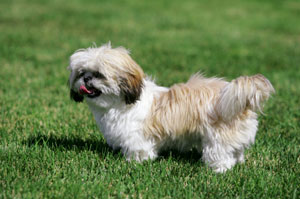
Care and exercise
The Shih Tzu is a high-maintenance breed, unless you choose to clip that glorious coat off which some owner prefer to do with their very old dogs. However, assuming that the beautiful hair is a large part of the attraction of owning this breed, you will want to maintain it in the best possible condition. This means never missing a daily grooming session of half an hour to an hour (or more if you really enjoy it). Combing and brushing, cleaning around the eyes and checking the ears are the routine, with a dry shampoo or bath every few weeks. This breed will generally get its own exercise around the house, but will always enjoy an outside walk or romp as well.
Suitability
With no vices, an endearing and charming personality and not much size, this is an indoor breed that can fit in anywhere, provided that it can be very much part of the family, and plenty of time and effort are available for its daily care and grooming. The Shih Tzu is an ideal breed for the person who loves lavishing affection on their dog and enjoys the act of brushing a long, luxurious coat.
This very popular small dog makes a wonderful doggy companion. This highly intellectual breed will have you eating out the palm of its handor should we say paw!
First, lets clarify the pronunciation say it as Sheed Zoo, or Shid Zoo, and either way it means lion dog. Believed to have originated in Tibet, its forebears are said to include the Lhasa Apso, Pekingese and Pug. The Shih Tzu reached the western world via China in the 1930s and has never looked back. Small but with plenty of substance, what it lacks in size the Shih Tzu makes up for in intelligence, charm and arrogance, not to mention glamour! One of the all-time great lounge-lizards and lap-dogs, the Shih Tzu revels in its daily grooming session. And why not? Its the canine equivalent of us having a full body massage every day! A delightful, amusing, affectionate and very intelligent little dog, the Shih Tzu loves being part of the household and is particularly good with children.
With a long, straight, dense coat reaching the floor or more, and any colour being permissible, this breed is canine beauty personified. Such is the length of hair over the face that the Shih Tzu usually wears a bow or clip to hold it up in a topknot. Adult height should be about 25cm, and weight between 4.5 and 8kg.
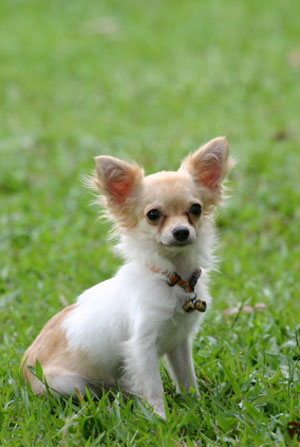
The diminutive Chihuahua may be classified as a Toy breed, but this little fellow is a tonne of heart and courage packed into a small, adorable body.
Personality: An affectionate and alert little dog which adores its family and will protect its guardians with its life.
Favourite activities: This little pooch likes nothing more than spending time with its owners and is said to love cuddling up, even creeping under the blankets of its owners bed at night. It will happily do whatever you do and will enjoy a daily walk, although the breed does not need lots of exercise.
Backyard requirements: Because of its small size, the Chihuahua does not need a big backyard and can happily live in a small space as long as it gets lots of love and attention. However, don’t be fooled by this pooch’s small build; if left outside and ignored, it can wreak havoc in the garden.
Suitability: With early training and socialisation the Chihuahua will get along with most people, but many breeders are wary of selling pups to families with small children as the diminutive dogs can get easily injured. This breed is especially good with older people and singles because it is small and easy to care for.
Watchdog qualities: Strangers beware! The Chihuahua may be small but it will defiantly alert its owners to anyone it is not familiar with. This breed is wary of strangers and, sometimes forgetting its small size, will bravely take on a much bigger opponent in order to protect its family.
Feisty and energetic, the Chihuahua is the epitome of a big dog in a small package. It is fiercely loyal and despite its small size, will take on anything which threatens it or its family in typical David and Goliath fashion.
With its origins dating back to the 1850s, this breed takes its name from the Mexican state of Chihuahua. It is said to descend from the Cannis Raptor Rodentis or Killer-Dog Mouse which lived in the deserts of America and Mexico. The Chihuahua flourished until the early 1900s but then waned in popularity. When American tourists began visiting the region in the 1920s, the little dog gained popularity with them and today is one of the most loved house pets around the world.
The Chihuahua is again experiencing a rise in popularity due to its Taco Bell infamy, and also because of its gorgeous pixy-like appearance and convenient size. With its beautiful, large dark eyes, this little pooch has been responsible for persuading even the most astute Chihuahua owner to give in to certain demands. This, says long-time Chihuahua owner and breeder Joan Pettit, is a dangerous mistake.
This dog must know from day one who is boss, says Joan, who, as well as a breeder, is also a Group One Chihuahua show judge. They must know the pecking order because they are very manipulative and will try to take over.
The Chihuahua is said to be very intelligent so is easy to train, but Joan emphasises you must be firm and preferably training and socialisation should start as early as possible. Ten to 15 minutes a day is enough, with rewards for good behaviour, she says. And always remember who is training who. Often it will be the Chihuahua who will end up doing the training!
Breeders stress that although the Chihuahua is small, it is not small in character and will defiantly protect itself if necessary.
I will not sell a puppy to families which have children under 10, states Joan firmly. This is not a dog which can be expected to sit still and be cuddled all the time.
If placed in the right family, however, the little Chihuahua will prove to be exceptionally loyal and will reward its guardians with never-ending love and companionship. This breed is especially well suited to older people as it is compact and easy to carry around, as well as simple to care for.
They will adapt to whatever you do, says Joan. They will want to please you constantly and will always be there with the most beautiful greeting when you get home.
While both the long- and short-hair varieties are easy to care for, the long-haired breed will need some extra attention. They will shed more and their coats can get matted if not brushed regularly. The long-haired variety will also need more frequent bathing.
Breeders point out that because of its small size, the Chihuahua can feel the cold more than other dogs so they need to be kept warm in winter. However, don’t always assume that if your pooch is shivering its because it is cold. It is characteristic of this breed to shiver if it is excited, unhappy or frightened.
Because of its profile from the Taco Bell ad, the Chihuahua has become the latest target of backyard breeders so experts emphasise that prospective buyers should look only at dealing with registered and reliable breeders if they want a sound and healthy pup. And if you shop around carefully and do the right thing by your dog, you will be rewarded many times over, they say.
This is the cutest dog, says Danni Blackburn, who is the proud owner of seven-year-old Ren. They are very loyal and easy to maintain. My dog is cheap to feed, I can take her anywhere and she doesn’t need lots of space.
Danni points out that Ren is wary of strangers and doesn’t really have time for new people, but will accept the person once she gets to know them. When it comes to loyalty, however, Danni couldnt do better. Ren clearly has eyes only for her guardian, following her around everywhere.
She is very lovable and adores snuggling up. So when its really cold and she creeps under my sheets, I have my very own hot-water bottle at night.
The Chihuahua descended from a desert-dwelling dog which developed the famous Chihuahua parasol-like big ears to survive in the hot desert conditions. The ears shaded the face from sun, and also collected moisture from the air and condensed it through the skin, supplying the dog with water. New-born pups were shaded from the sun by their mum’s big ears and in winter, those same ears would be used to snuggle up in.
Daily: Spend lots of time with your Chihuahua and provide copious amounts of love and cuddles. This is not a breed to be left to its own devices.
Weekly: A brush once a week, extra brushing for the long-coated variety. Make sure eyes and ears are clean.
Monthly: Check if toe nails need clipping. Bath if necessary but always take care not to get water in the ears as infection can occur.
Other: Heartworm and flea treatments, gastrointestinal worming every three months for adults, more frequently for puppies. Raw bones regularly will keep your pooch’s teeth clean.
Hereditary diseases: Chihuahuas are prone to weak knees but buying from a registered and reputable breeder will reduce the possibility of buying a puppy with an inherited problem.
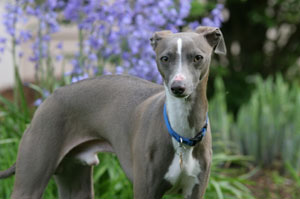
Care and exercise
Like most toy breeds, the Italian Greyhound will give itself enough exercise just running around the house, but will welcome the opportunity for a walk, provided it has been accustomed to the outside world. Loud noises, traffic, other bigger dogs, strangers, crowds and unfamiliar places can be particularly daunting to this timid little dog if it has not been safely introduced to them as a puppy. Children must learn to treat this breed with care, as those slender IG bones are easily broken, especially in puppyhood. Their slight build with little fat means that these dogs feel the cold more than most breeds. They should be given warm bedding and should always be dried off quickly after getting wet. Coat care consists of the occasional bath this should not be required very often and regular wiping over with a hound glove or soft cloth. Toenails should be checked regularly and clipped or filed when necessary.
Suitability
Perhaps not the best choice where a robust, knockabout family dog is required, the Italian Greyhound is an ideal breed for the older person who appreciates a gentle, affectionate, refined, graceful, elegant and easycare little companion, who will also let them know when a visitor has arrived.
This lovely sighthound is a compact lovable breed just waiting to be welcomed into your loving home.
This very old breed is Italian in name only, since there is evidence that it existed in Egypt some 2000 years ago. It was for several centuries the favourite of Italian nobility and this is no doubt the origin of its present-day name. Very much a true miniature version of the Greyhound, this tiny toy breed still carries the instincts of the hunting sighthound, although its size restricts its possibilities somewhat! A very slender, graceful dog with fine bones, the Italian Greyhound is not as delicate as it looks, at least physically. It should not, however, be allowed to run with bigger dogs and children need to be conscious of its size when playing. The Iggy, or IG, as its breeders call it, has a quiet, reserved, gentle, affectionate nature and may have a tendency to timidity.
Weighing all of 3 to 4 kilos wringing wet and standing around 25-30cm at the shoulder, this neat little dog with its very short, smooth coat comes in black, blue, cream, fawn and red, all with or without white markings. It also comes in all white. A characteristic of this dainty breed is its high-stepping, almost prancing action when walking.
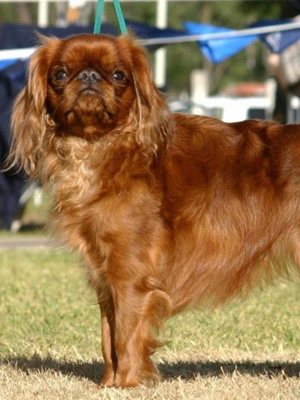
It’s no wonder this gorgeous breed is winning the praise of thousands across the globe. Lauren Nethercote discovers the wonderful King Charles Spaniel that has heads turning and hearts melting.
The oldest English breed in the Toy group, the King Charles Spaniel carries the Kings name by royal request. King Charles II of England owned quite a few of these charming little comforter dogs. During the 19th century, the King Charles Spaniel underwent several changes. It was bred smaller, with a flattened upturned face, protruding eyes and a more rounded skull. The result is today’s King Charles Spaniel, known in America as the English Toy Spaniel. The King Charles Spaniel, which ranks among the rarer breeds in Australia, should not be confused with its larger cousin, the Cavalier King Charles Spaniel. Today, the King Charles Spaniel is a popular family companion, being extremely affectionate and loyal.
A person who knows the Charlie all too well is enthusiast Blair Edgar, who has been involved with the breed for 15 years. He is also vice president and patron of the King Charles Spaniel Club Victoria. King Charles Spaniels are independent, autocratic, aristocratic, very loving and attentive. This breed is first and foremost a companion dog; they thrive in that role and are companions par excellence, Edgar says. Dogs Life also speaks to Ken Ball, who for 25 years has been involved with the breed and imported breeding stock from New Zealand and England. King Charles Spaniels are for the connoisseurs, a person who wants a companion dog, he says.
Loyalty plus
This delightful breed gets along wonderfully with children and other dogs, but will do better with older children early socialisation is a must. As with all breeds, children should be supervised.
Charlies are often used as companion dogs; they are bright, happy, full of fun and love nothing more than a cuddle on your lap. They are excellent family companions, howe’ver due to their small size and flat faces, they are not suitable for young children, Ball tells Dogs Life.
Despite their gorgeous looks, King Charles Spaniels make good watchdogs; they are fiercely protective of their owners and their own space. The King Charles develops a distinct rank and pecking order. Once you have its confidence, a Charlie is your friend for life.
They will set off the alarm system loudly and will defend their favourite person. King Charles Spaniels are brave, unafraid and will give their lives for the person they love, Edgar says.
Ball also mentions to Dogs Life that the King Charles Spaniel will certainly let you know of anyone approaching the front door and will bark loudly to protect their house.
The breed loves human companionship and does not adapt well to solitary life in a backyard. If they do spend time in the backyard, ensure it is safely fenced. They like exercise; they will also like sitting or lying on the very best sofa, chair or cushion and claim it their throne, Edgar says. They will walk as far as you will. It is important to keep their muscles toned and minds occupied. The King Charles loves to run, play and chase butterflies.
Small, agile and smart
The King Charles Spaniel is extremely intelligent and responds well to training, but can be stubborn at times. They need to be taught basics in fun, short, 10-minute bursts, and they respond well to the positive-reinforcement method. The breed is naturally well-behaved, but can be wilful. They have incredible, extraordinary and very acute memories; they do not forget anything, Edgar tells Dogs Life. The King Charles is easily trained and can perform at any level. Charlies do not follow other peoples rules; they do it their way. They sit when you want them to stand, they will turn their heads away when you want them to look at you, but produce a camera and just watch them pose.
To keep their beautiful, long, silky coat free from mats, regular brushing is required. The King Charles Spaniel should be brushed daily with a bristled brush and comb, and its advisable to keep the area around its eyes clean with wipes. There is no need to clip their coat in summer, as it is a natural insulator. The King Charles Spaniel is generally a robust and healthy breed, with no hereditary diseases recorded. Purchasing from a responsible breeder is recommended. Most breeders take time to study the bloodlines with the intent of eventually breeding any problems out of their bloodlines. The lifespan of this loving breed ranges from eight to 12 years, although it is not unheard of to see the King Charles Spaniel reach 15 years.
The King Charles Spaniel Club of Victoria: http://members.optusnet.com.au/kingcharlesspanielclub/
For more information or a breeder in your area, contact your state canine council via the Australian National Kennel Council (ANKC) website at www.ankc.org.au
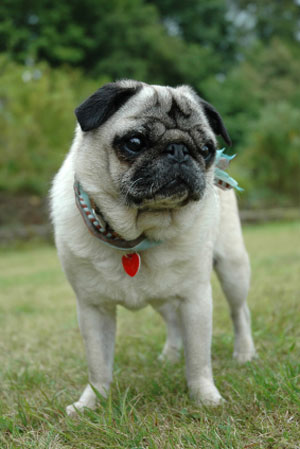
Pug dogs are gentle in nature and are great as a family pet.
Personality: These little dogs will have you in stitches with their attention seeking comedy acts. They are made of heart-melting goodness with great temperament and inquisitive nature.
Suitability: Great for singles or family environments that are looking for a charismatic companion. Pugs are best suited to people who have a lot of time and love to give as the breed thrives on human affection. They are tolerant and gentle with children, but like all breeds they should be supervised when interacting with any little ones.
Favourite Activities: Getting their paws into anything you are doing! These little shadows will take great delight in following you around the home and helping with the housework, but they also love to get out and meet new friends, both doggy and human.
Watchdog Qualities: Pugs will bark to let you know when visitors arrive but they are generally very friendly towards all humans, be they friend or foe.
Backyard Requirements: Pugs need very little space and will happily live in an apartment as long as they get a walk each day. The do not like extreme heat or cold, and would prefer to live inside the home.
Looking for a friend? You’ll find one in the Pug; the most wonderful companion in the world according to Pug fanatics. And Pug aficionados agree that while many breeds are faithful and loyal, the lovable Pug takes top prize for these attributes.
Bred specifically as a companion dog, the Pug is a lot of dog packed into a little body. In fact, this breeds stocky, thickset and muscular-looking body, closely resembling the Mastiffs in style, could lead some to believe the Pug is a fighter. However, nothing could be further from the truth. With its distinctive, large, pool-like eyes and irresistible wrinkled face, this little pooch was born to love, filling its home with affection, humour and fun. It will stick close to those it loves, often pressing up against its owner just to feel them, burrowing in for a cuddle and often sprawling across one of its favourite places of all the human lap!
Felicity Way, from Canberra, has owned and shown Pugs for 20 years, as well as being a national and international judge of the breed. In her opinion, the best thing about these little dogs is their love of humans and their fantastic nature.
Each one is an individual, with its own quirks, likes and dislikes, explains Felicity. We’ve had many other breeds, but the day the Pug came into our lives it captivated our household.
Felicity stresses this is not a breed for people who are too busy to put in time and effort, emphasising that the Pug is definitely a house dog.
This animal was originally bred to live in temples, she says. That’s its heritage. This is not a dog for the yard or an outside kennel. Its human-oriented and needs to be with its owners.
Adelaide-based Patsy Muirden has owned and shown Pugs since 1956 and agrees that this dog is meant to be part of its owners life.
The Pug should never be kept in kennels or on concrete, states Patsy. In fact, their lot in life is to be a person!
Despite the fact that Patsy is now in her seventies, her Pugs still feature prominently. Her five-year-old Champion Patrian Chaucer took out Best in Show in both the 1998 and 1999 Pug Specialty in Melbourne. And what is it about these dogs that has kept her captivated for so many years?
Its their predictability, says Patsy. They’re so easy to live with. They don’t bark at every little thing and they’re not highly strung or excitable. They’re intelligent and have great personalities. And by the way, she adds, one Pug deserves another! After all, there needs to be two so they can rest their chins on each other.
While the Pug is easy to look after, owners need to maintain a degree of vigilance to ensure their pets remain healthy. For example, heat and humidity are the Pugs enemies and can prove lethal in some situations. The Pugs cooling system is limited due to its flat face and the dog can easily overheat. Similarly, they dislike the cold and are prone to catching colds. And while this breeds to-die-for eyes can melt the hardest of hearts, they can be the Pugs undoing if owners aren’t watchful.
New South Wales Pug expert and international show judge Kerry Cannon, who bred Don Burkes Pug Ralph, can’t stress enough the importance of guarding a Pugs prominent and therefore easily damaged eyes.
This dog is wonderful around children, but kids can be rough and they can easily damage a Pugs eyes, she says. Some experts even warn about the presence of cats and suggest that any pointy or dangerous objects lying around be removed or they could inadvertently poke the large exposed surface of a Pugs eye.
As for the theory that Pugs eyes pop out, Absolute nonsense, claims Kerry. Pugs eyes are bulbous so it could be easier for their eyes to pop out than those of some other breeds, but the dog would have to be grabbed by another dog for it to happen. In all my time connected with this breed, I have only known of two dogs whose eyes have popped out. Unlike some other breeds, such as the King Charles Spaniel, this problem is not prevalent in the Pug.
Can one lose sleep if bombarded nightly by the famous Pug snore? They do snore, but so do old people, laughs Kerry. She stresses that the breed does not have a breathing problem and is perfectly healthy if looked after properly. Sometimes you can hear a Pug panting away, but that’s often caused by heat, which causes stress, making the dog pant. Its not a breathing problem.
Snoring, common in many short-nosed breeds, simply comes with Pug territory and has to be accepted. Some owners even get to enjoy the sound. I love it. To me its such a soothing sound, enthuses one Pug lover.
According to Felicity Way, Pugs will snore in varying degrees and it does take some getting used to. But, she adds, its all part of the special Pug package. Pugs love all members of a family but often they get especially attached to one person, she relates. That’s the case with me and my Pug Bert. Sometimes hes like an immovable rock. He stretches out across three-quarters of my bed, leaving me a very generous one-quarter for the night.
The Pug comes in a variety of solid colours, ranging from fawn to apricot and silver, with a black mask on the face and black ears. Black Pugs, which some say can be noisier and more mischievous than others, should have no markings. The head should be large and round with clearly defined wrinkles and a short, flat muzzle.
The tightly curled tail sits over the hip and can become very animated in an excited Pug. The dogs eyes are prominent, expressive and dark. They should not be overly moist and if they appear so, should be checked by a vet.
When it comes to training, the Pug will catch on fairly quickly but does have a stubborn streak. Being a dog that is known to sell its soul for a tasty morsel, however, food rewards for good behaviour can go a long way. (Beware of overfeeding as the food-loving Pug is prone to obesity.)
While the Pug can fulfil the role of watchdog, barking if the doorbell is rung or when a stranger approaches the house, the Pug Club of Victoria warns the dog is likely to lick a burglar to death, despite its initial deep barks and growls.
Experts recommend early socialisation and obedience training, but warn that when it comes to toilet training in cold weather, your Pug could baulk at the idea of going out in the cold and the rain. Having a dry area for toilet-training could be beneficial.
Michael Bay, from Melbourne, still laughs nostalgically when he thinks about his pet Pug Tamar who, together with the familys Chihuahua (which was named Hercules), used to keep them in fits of merriment. Tamar was a member of our family for many years, recalls Michael, and she was very much an integral part of all our lives. We used to call her the vacuum cleaner because she would race around the house, nose to the floor, and because of her flat face it was almost as if she was vacuuming as she moved. When she finally died, an old lady, she left a big gap in all of us. She was really gorgeous.
Origin
Its believed the Pug first appeared in China, where there was a short-coated Pekingese-type dog known as the Happa-dog, which may well have been the forebear of our modern Pug. They were reportedly in China as far back as 1115 BC, but it wasnt until 663 BC that short-mouthed dogs are mentioned. They were often treated like royalty and were kept by the emperors.
Some varieties of Pug eventually found their way to the continent, particularly Holland, probably through the Dutch East India Company. Pugs appeared in England in about 1688 and their popularity spread, with courtiers parading their dogs adorned with orange ribbons. They remained a popular breed into the reign of George III (1760-1820), when his wife Charlotte kept large numbers.
Later, the breeds popularity began to wane and by 1867 it seemed cross-breeding was leading to the Pugs demise. But the little dog had a resurgence in popularity in the Victorian era.
Its believed the Pug came with migrants to Australia in the 1860s. The first record of them being shown was at the Sydney Royal Show in 1870.
Royal pugs
The Duke and Duchess of Windsor were Pug fanatics, owning 11 over the years and amassing a huge collection of Pug memorabilia. They were known to have sheets embroidered with the word Pug, engraved leashes, numerous paintings of Pugs, a gold matchbox holder with the names of some of their Pugs engraved on it, porcelain Pugs, porcelain dog bowls decorated with pictures of Pugs, Pug paperweights, even letter openers decorated with images of the much-loved pooch.
A few years ago, the Windsors collection was auctioned by Sothebys, with bidders paying well into the thousands for the various items. Most went for more than the reserve, with Pug lovers snapping up treasured pieces of Pug royal history. A much cherished portrait of the Duke of Windsor and one of his adored Pugs went way past its expected price, finally selling for $18,400.
Grooming
It doesn’t take long to groom a Pug but they do love to be brushed and fussed over. I groom my Pugs with a soft bristle brush, a velvet mitt, a bottle of baby oil and a box of tissues.
Twice a week I brush with the soft brush to eliminate dead hair and dirt from the coat. Once the dead hair is removed, I brush with the velvet mitt which enhances the coats lovely shine. Fawn Pugs have a double coat which takes a little longer to brush than the single black coat.
Once a week I clean the face, paying attention to the nose roll (the roll of fat that sits on top of the Pugs nose). Dab your tissue in some baby oil and gently rub under the nose roll. You’ll be amazed how much dirt and grime collects here.
The Pug also enjoys a bath and loves to be roughed up while being dried. I bath my Pugs regularly once a month in winter is adequate, and weekly in summer, mainly because they enjoy it so much!
A loyal friend
The Pug is renowned for its loyalty, with stories abounding of its death-defying attempts to protect its owners. In 1572 in Holland, Prince William of Oranges life was saved when his beloved pet Pug set about trying to warn the prince of the approaching Spaniards. The little dog, which slept beside the prince, apparently barked and licked its owners face to try to wake him.
The Pug also rose to fame in 18th century France when it became much adored by Napoleons wife, Josephine. When she was later imprisoned, she apparently sent messages, tucked under her Pugs collar, to Napoleon. And rumour has it that the famous Pug bit Napoleon when he entered Josephines room on the night of their wedding!
Daily: Pugs should be provided with a balanced diet. Provide clean, fresh water and make sure the dog always has shade or a cool place for hot days. Being a brachycephalic breed flat-faced it could become stressed if left in the sun for prolonged periods.
Weekly: Bathing in summer. Facial care. Twice-weekly grooming.
Monthly: Heartworm and flea treatment.
Other: Gastrointestinal worming for adult dogs every three months, more frequently during puppyhood. Annual vaccinations.
Hereditary diseases: Include wry mouth, hemi vertebrae, hip dysplasia, disticea and entropian. Buying from a registered breeder who tests for hereditary diseases can help lessen the risk of purchasing a dog with problems.
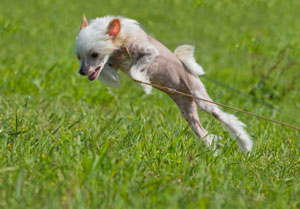
Care and exercise
The powder-puff variety, which can occur in the same litter as the baldy, requires daily grooming to prevent mats and tangles, but it is not a heavy coat and on such a small dog this is not a difficult task. The hairless needs only about 30 seconds brushing its five lots of hair, but daily attention must be paid to its skin, by way of cream or oil applications to keep it soft and supple. Exposure to our hot sun should be kept to a minimum and high-protection sunscreen applied beforehand. Exercise requirements are minimal, but because the lack of a protective jacket makes the hairless variety very susceptible to the cold, outside exercise should be confined to the warmer months. Their dentition problems mean that bones or hard biscuits are usually best avoided.
Suitability
Being a very small dog, the Chinese Crested is eminently suited to house or apartment dwelling, with little need for much garden space. It is a quiet breed, gets on with other dogs, becomes devoted to its family, is very good with children (who must be taught to play gently because the skin is easily damaged) and is the ideal breed for those wanting something different and who are prepared to give it constant company and look after its skin.
This loving little breed is perfectly suited to many environments and people, making it a perfect companion for any living situation.
A true canine curiosity, the origins of this fascinating, ancient little dog are the subject of much conjecture. Believed to be related to other hairless breeds, such as the Mexican and Peruvian Hairless and also the Chihuahua, a Central American background seems possible. Some authorities consider this to be the most likely scenario, while others suggest that Africa, Turkey or China could be the areas of origin. In any case, its apparent existence in ancient China led to its present-day name.
Its peculiarities include the hairless body with its warm, fine-grained skin; the elongated feet with longer than usual nails; and the fact that many are born without a full set of teeth, or lose teeth very early in life. There is also a coated variant, called the powder puff, which has a soft veil of hair all over. The hairless variety of Chinese Crested has, as the name suggests, a long, flowing crest of hair on its head, a plume on its tail and socks on all legs, and no other hair on its body.
The Chinese Crested is usually a merry, affectionate little dog who is happiest when with his owner. This is a breed which loves company and quickly becomes devoted, but is reserved and even shy with strangers. It can come in any colour, and generally reaches around 32cm tall and about 5kg in weight.
DogsLife is proudly powered by WordPress
